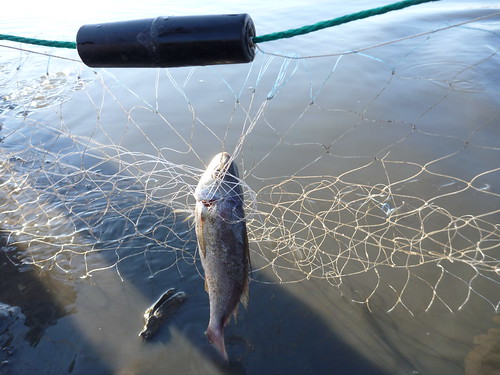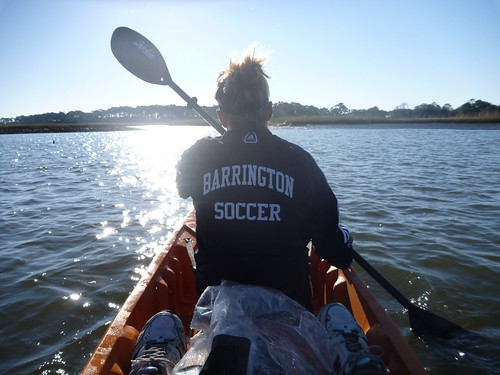Rob Diaz de Villegas WFSU-TV
 The first leg of David Kimbro’s Roctober oyster push is now complete. If you look at the schedule below, you’ll see the first day was intensive, starting in the wee hours and going late into the night. As David mentioned in his post, the head of the NC team (Jon Grabowski) was along for the fun. David was Jon’s lab tech once upon a time, as was Dr. Randall Hughes (In the Grass). So tagging along I definitely got some “family reunion” vibes, with lots of good natured ribbing (let’s just say it was good-natured).
The first leg of David Kimbro’s Roctober oyster push is now complete. If you look at the schedule below, you’ll see the first day was intensive, starting in the wee hours and going late into the night. As David mentioned in his post, the head of the NC team (Jon Grabowski) was along for the fun. David was Jon’s lab tech once upon a time, as was Dr. Randall Hughes (In the Grass). So tagging along I definitely got some “family reunion” vibes, with lots of good natured ribbing (let’s just say it was good-natured).
For this October push, David will be breaking in a new boat to help his team cover ground more efficiently while lugging traps and samples around. In order for the boat to move in shallow water, David replaced the motor with a lawnmower engine. It worked fine on Thursday, when the water was higher, but it had a few problems Friday morning at low tide:

Jon Grabowski drags the boat- along with and Tanya and Alicia- after not being able to drive the boat through shallow waters.
Finally, they were able to get it to go. The solution? As David’s tech, Hanna, said- “Just Gun it!”
The catch this time was a little different than the last, with new fish like Red Drum ending up in the gill nets and no juvenile fish being caught in the minnow traps. They also started looking into the stomachs of some of the predators (they have a permit to do so if the fish die in the net) and are seeing that the catfish here are eating mud crabs. Mud crabs, of course, are key oyster predators.
We’ll be heading out with David’s crew throughout the week. On top of all of the other arrangements they have to make to move their crews around multiple sites hundreds of miles apart, they have to accommodate our camera crew. So thanks for finding a way to drag us along! Hopefully we can show people the kind of work that goes into making this kind of research happen. There’s a lot of work to go along with the science, and with every subsequent sweep and new experiment, the patterns will hopefully clarify and our understanding of these ecosystems- and how to best conserve them- will be that much further advanced.
David’s crew has been split into two teams, the Net/Trap team (N/T) and the Tile team (TI). For a closer look at how David’s team nets and traps larger fish and crabs, click here. To learn more about what the Tile team will be doing, click here. And if you click On the Reef under categories in the sidebar, you can track David’s progress over the course of this study.
Thursday, October 21- Alligator Harbor
8:30 AM– Retrieve tiles, sediment, and spat. (TI)
11:07 AM– Deploy traps (N/T)
5:07 PM– Retrieve traps. High tide activities: reference water level, water samples, replace spat sticks. Unlike in the previous sampling done in Alligator Harbor, there were no juvenile pinfish or pigfish.(N/T)
8:00 PM– Deploy nets. The nets will be retrieved Friday morning to give David an idea about what was swimming around over night. (N/T)
Tide Times and height (ft.) for Alligator Harbor, October 21, 2010
Low- 8:07 AM (0.2)
High- 2:12 PM (2.7)
Low- 8:07 PM (0.9)
 Friday, October 22- Alligator Harbor
Friday, October 22- Alligator Harbor
8:00 AM– Retrieve nets, data logger. Today there were a lot of red drum (redfish) and of course, catfish (hardhead and sail). On site dissection reveals that the catfish eat mud crabs, thus serving the same role that toadfish serve in North Carolina reefs. (N/T)
8:30 AM– Return tiles/ oysters. The tiles for the new spat experiment mentioned by David go out today. (TI)
Tide Times and height (ft.) for Alligator Harbor, October 21, 2010
Low- 8:40 AM (0.1)
David and his team are taking Saturday off. Bright and early Sunday morning, the Net/ Trap team heads for Cedar Key while the Tile team heads to Saint Augustine.


